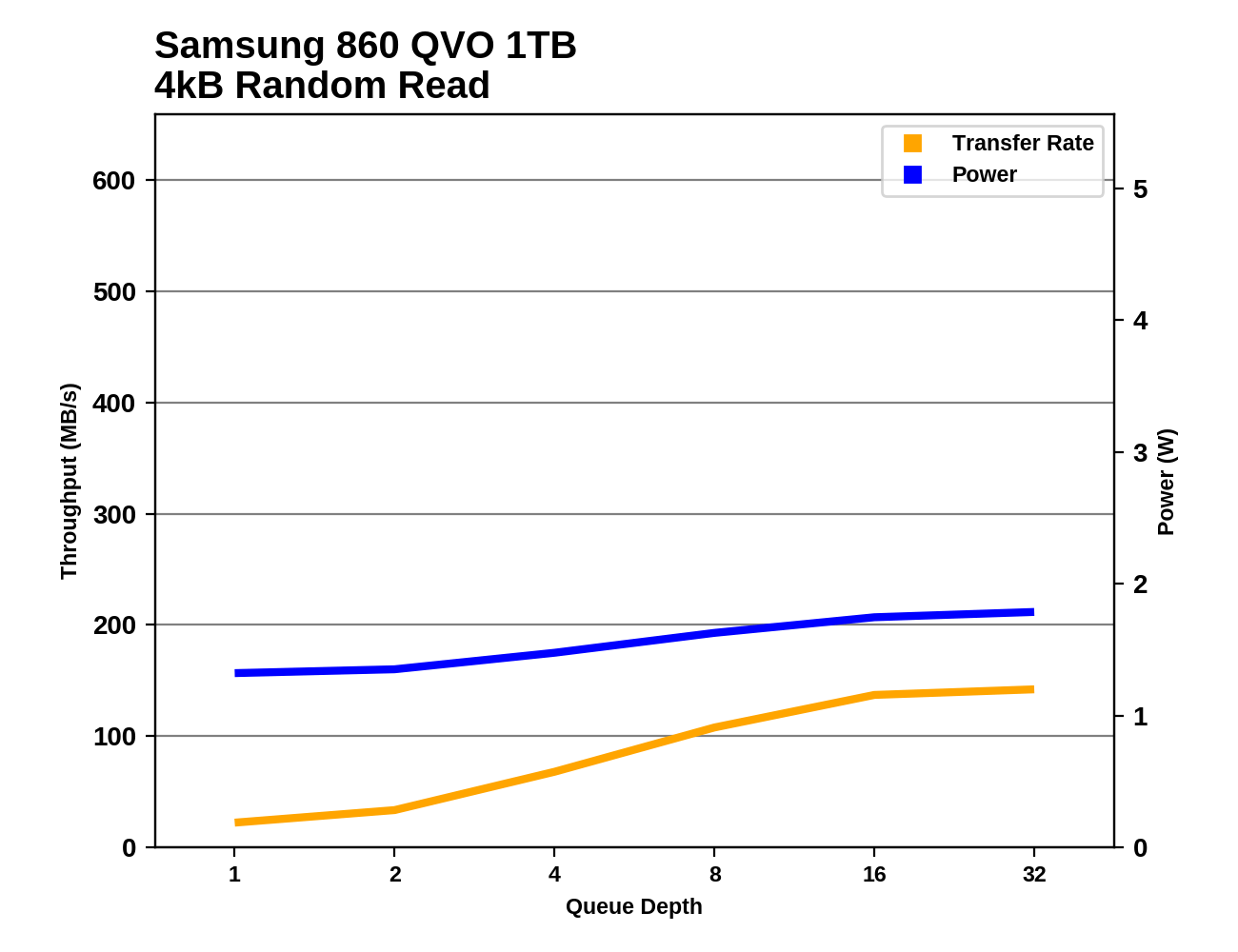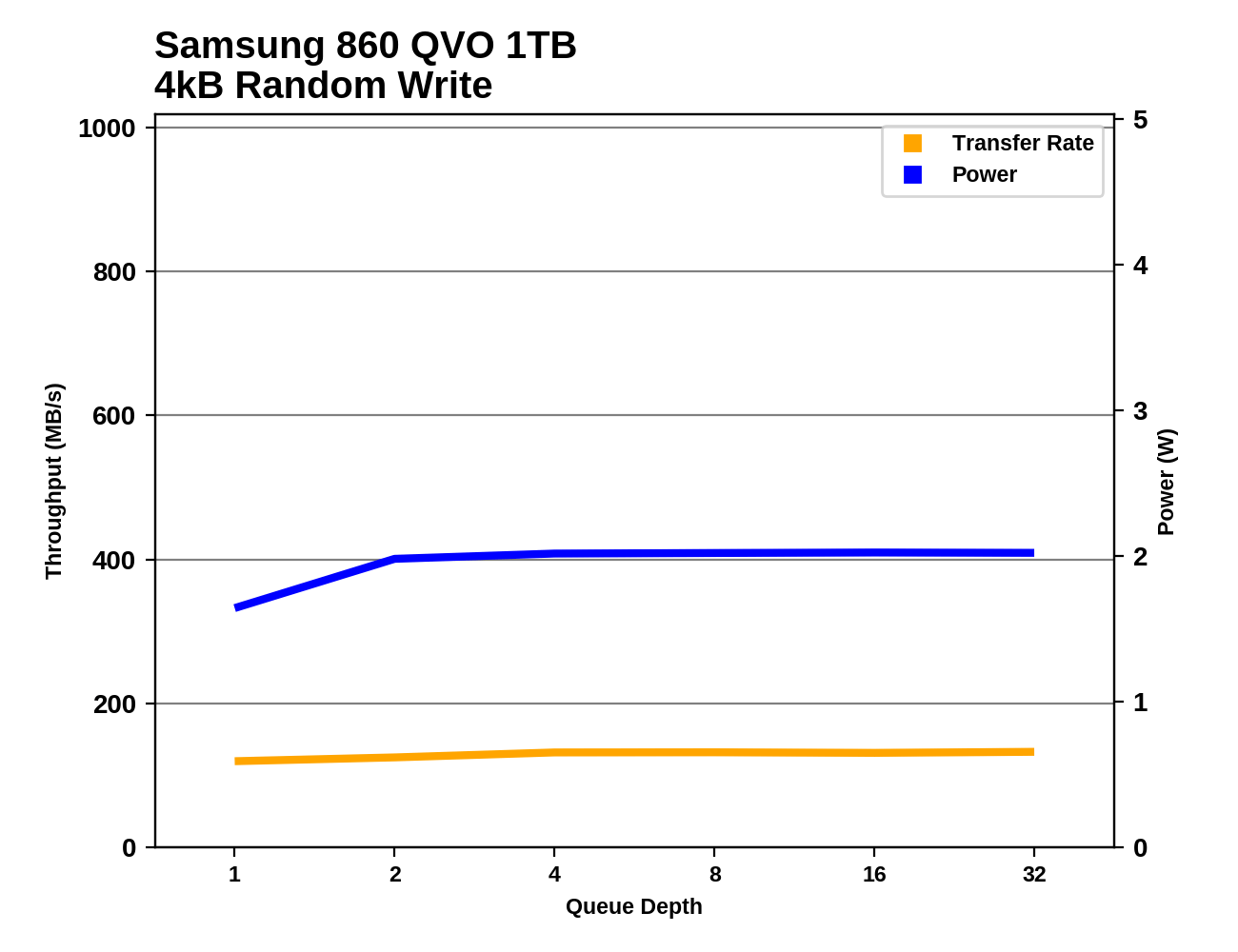The Samsung 860 QVO (1TB, 4TB) SSD Review: First Consumer SATA QLC
by Billy Tallis on November 27, 2018 11:20 AM ESTRandom Read Performance
Our first test of random read performance uses very short bursts of operations issued one at a time with no queuing. The drives are given enough idle time between bursts to yield an overall duty cycle of 20%, so thermal throttling is impossible. Each burst consists of a total of 32MB of 4kB random reads, from a 16GB span of the disk. The total data read is 1GB.

The burst random read performance of the Samsung 860 QVO is clearly lower than the 3D TLC competition, while the Intel/Micron QLC NVMe drives have no trouble competing against the field of mainstream SATA TLC drives. Even in the worst case of the smallest QVO being entirely full, read speeds are still vastly better than a hard drive.
Our sustained random read performance is similar to the random read test from our 2015 test suite: queue depths from 1 to 32 are tested, and the average performance and power efficiency across QD1, QD2 and QD4 are reported as the primary scores. Each queue depth is tested for one minute or 32GB of data transferred, whichever is shorter. After each queue depth is tested, the drive is given up to one minute to cool off so that the higher queue depths are unlikely to be affected by accumulated heat build-up. The individual read operations are again 4kB, and cover a 64GB span of the drive.

On the longer random read test, the Toshiba TR200 DRAMless TLC drive is no longer able to stay ahead of the 860 QVO, and even the Intel/Micron QLC drives fall behind most mainstream SATA drives (especially when full).
 |
|||||||||
| Power Efficiency in MB/s/W | Average Power in W | ||||||||
The power consumption of the 860 QVO during the random read test is only slightly higher than its TLC-based relatives, but that's plenty to push its efficiency scores into last place, given the poor performance.
 |
|||||||||
The queue depth scaling of the 860 QVO during random reads is fairly typical in shape, with improvements starting to taper off after QD16. However, the vertical scale is important: the QVO doesn't ever reach even half the performance of the best TLC-based SATA SSDs.
Looking at the 1TB 860 QVO's random read results compared to all the other SATA drives in the benchmark database, it is clear that the QVO isn't anywhere near the cutting edge for power efficiency or peak performance, but there are worse drives out there.
Random Write Performance
Our test of random write burst performance is structured similarly to the random read burst test, but each burst is only 4MB and the total test length is 128MB. The 4kB random write operations are distributed over a 16GB span of the drive, and the operations are issued one at a time with no queuing.

The SLC cache of the 860 QVO is very effective for the burst random write test, leaving it tied or slightly ahead of the 860 EVO.
As with the sustained random read test, our sustained 4kB random write test runs for up to one minute or 32GB per queue depth, covering a 64GB span of the drive and giving the drive up to 1 minute of idle time between queue depths to allow for write caches to be flushed and for the drive to cool down.

On the longer random write test, the larger SLC cache and greater parallelism of the 4TB 860 QVO helps it keep pace with other top SATA SSDs, but the 1TB QVO has to settle for being slightly faster than the DRAMless TLC drive.
 |
|||||||||
| Power Efficiency in MB/s/W | Average Power in W | ||||||||
The QVO is again a bit more power hungry than most of the TLC drives, which doesn't hurt the 4TB QVO's efficiency score much thanks to its good performance, but the 1TB QVO ends up tied for last place with the full-drive performance from the Intel/Micron QLC drives.
 |
|||||||||
The 1TB 860 QVO shows very little random write performance scaling with increasing queue depth, though power consumption does go up significantly from QD1 to QD2. The 4TB 860 QVO shows a much more typical scaling up to saturation at QD4, with a performance curve that is almost an exact match for the 4TB 860 EVO.
There are some TLC SATA SSDs that draw the same power to deliver half the random write performance of the 1TB 860 QVO, but in the grand scheme of things the 1TB QVO's results on this test are sub-par. The 4TB starts out in the same spot but ends up hitting the SATA performance wall without consuming too much power.












109 Comments
View All Comments
stanleyipkiss - Tuesday, November 27, 2018 - link
Sell me a 8 TB QLC SSD for $400 and I'll bite. That's what QLC is for: moving off of spinning rust and onto SSDs with my bulk storage. Until then, this is useless without MASSIVE price drops. They are trying to milk saps who can't tell the difference between SSDs (i.e. normal consumers) by not dropping prices... yet.The race to the bottom for SSDs is coming. The manufacturers are just greedy enough not to want it to happen too soon.
But give me an 8TB or bigger SSD for $400 and I'll be the first to buy it. I'll even buy two!
R0H1T - Tuesday, November 27, 2018 - link
Yeah no one's selling you 8TB for $400 anytime soon. Aside from the fact that the R&D costs for QLC need to be recuperated first & companies need to reinvest an increasing amount for future development, there's also a point after which it doesn't make sense for the SSD, or NAND, maker to sell these at a loss.If you really want something that big, for dirt cheap, try spinners instead.
shabby - Tuesday, November 27, 2018 - link
How will they recoup the price when no one is going to buy this? The evo 860 is cheaper.R0H1T - Tuesday, November 27, 2018 - link
So you think the 860 QVO will stay at 15c/GB for the rest of it's time on the market or have you not seen high prices at launch, for any other product before this?shabby - Tuesday, November 27, 2018 - link
Obviously no, but why launch it at this price from the start. Should of launched it at $99 for 1tb that would probably get it some fanfare.R0H1T - Tuesday, November 27, 2018 - link
Early adopter tax? Samsung is usually the first to launch "one of a kind" products in the retail market & they get the ball rolling for many of the innovations in this industry. The prices would come down sooner if the competitors launch their SATA QLC drives quickly.shabby - Tuesday, November 27, 2018 - link
I doubt anyone will be rushing to the store to buy these.Ironchef3500 - Wednesday, November 28, 2018 - link
+1Jad77 - Wednesday, November 28, 2018 - link
"I doubt anyone will be rushing to the store to buy these."That is the perfect one-line review!
moozooh - Tuesday, November 27, 2018 - link
Yeah, the problem here is that the QVO is not a "one of a kind product"—in every possible aspect and scenario it's either the same as the EVO or worse, sometimes very substantially so, without being substantially cheaper. Right now there is exactly zero reason to choose it over the EVO. In order to compete with it favorably the QVO needs to be at least 25% cheaper to offset the disadvantages. In other words, under 11 c/GB. Until then nobody would be willing to give this inferior product the time of the day.